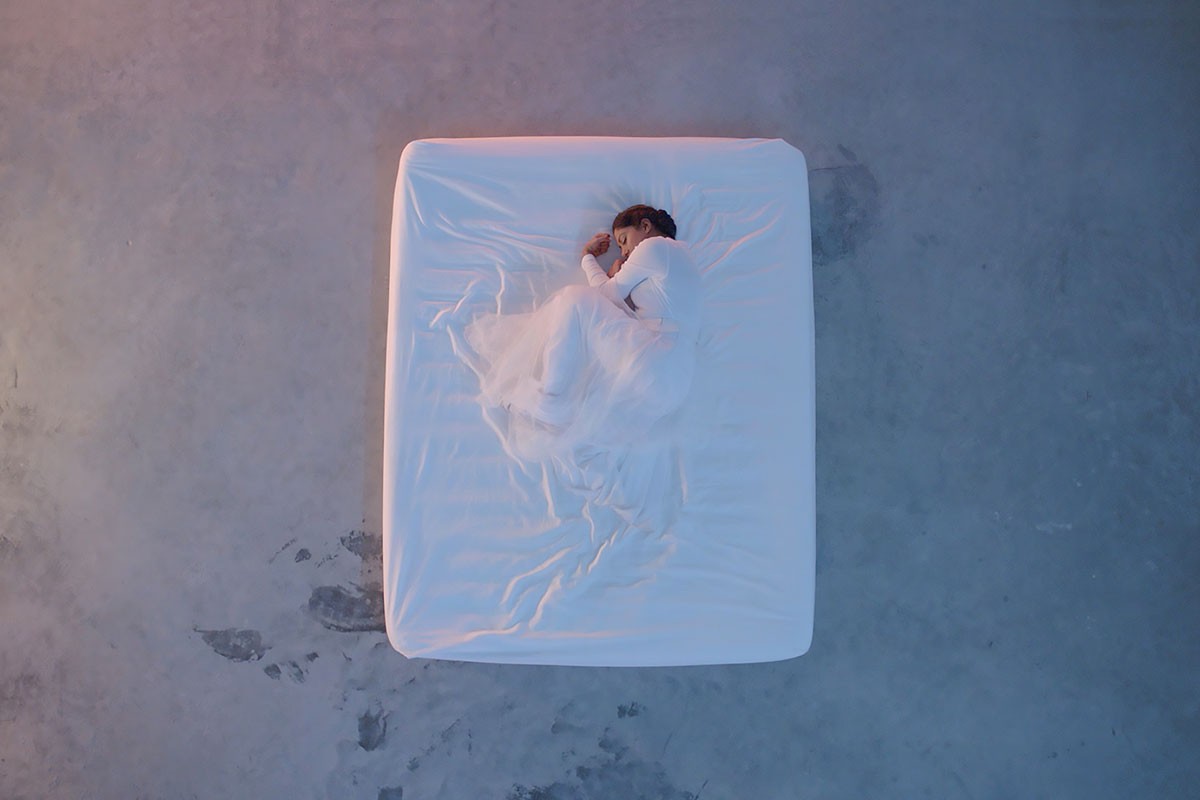The history of the Lumiere Collective lies in the neighborhoods of Dubai, a city that inspires the art they create. The artists—filmmaker Swapna Kurup and dancer Shereen Saif—have worked together in the United Arab Emirates for a decade after bonding over similar ethnic roots, hailing from the state of Kerala, India.
Lumiere, French for “light,” refers to the epiphanies and “unexpected realizations” they encounter during their multimedia collaborations. Kurup hopes that by translating their experiences into art, they give the audience autonomy over their own interpretations.
The collective first takes inspiration from their surroundings. “It’s about the land telling us the story, the space telling us a story,” Saif said.
Their first collaboration, the video art installation The Unmanifested, was commissioned for the 2014 Sikka Arts Festival in Dubai. Sikka is the Arabic word for “alleyway,” a space they took into consideration when designing the work. Captivated by tungsten-colored lights illuminating the Al Fahidi Historical Neighborhood, the artists selected a restored house in the area for their exhibition space.
“It was going to be a site-specific work, so we wanted the site to tell us something,” Saif said. “We were first impressed with just the shadows on the wall and the idea that these messages are from a different world.”
The pair then merged their two practices to create the video installation. As a performance artist trained in Indian classical dance, Saif incorporated three genres—Kathak, Bharatanatyam, and Mohiniyattam—into her act. Kurup drew from her extensive film directing experience to capture Saif’s hypnotizing movements within the space. Shown across three walls, The Unmanifested projects multiple silhouettes of Saif dancing within the dark room as symbolic expressions of “unmanifested” ideas.
“Any emotion that we hold, even as someone who is writing and filming and someone who is performing, will translate across the screen,” Kurup said. “Someone will connect it, so we try to keep things as personal as well can. We have to feel it first for someone watching it to feel it.”
*****
The United Arab Emirates is a country where expatriates constitute more than eighty percent of the population—around thirty-five percent of residents are from India, and half of the population is of South Asian nationality. In total, residents of around 200 nationalities live and work in the UAE.
As a result, the UAE’s creative community is diverse and attracts people from around the globe to participate in its bourgeoning art culture. Now one of the world’s foremost art hubs, the country is home to several big-name institutions, such as the Louvre Abu Dhabi and Sharjah Biennial, that support and exhibit local and international artists.
Art historian and curator Dr. Woodman Taylor partly attributes the boom in the UAE art scene to the government’s recent efforts to integrate the creative industry into the economy. For example, the Golden Visa—which offers long-term residency and was primarily given to investors—was recently expanded to include artists who could contribute to the UAE’s creative sector.
“That’s been a huge positive thing for continuing to build the arts community,” Taylor said. “The government is really behind that because they realize that’s a way they can build the economy away from oil.”
In this multinational context, many of the Lumiere Collective’s installations transcend language. They strive to convey universal ideas virtually everyone can resonate with. Yet they also understand the importance of inclusivity—in welcoming diverse perspectives and voices—when creating and sharing art in Dubai. Saif attributes the city’s significant expat population as a source for cultural exchange among artists and residents alike.
“That happens in mature societies, right? When everyone has access to it, when children have access to it, when families go and see these things,” Saif reflected. “Art is not something that you put up on a pedestal for intellectuals who go to art galleries and watch it and debate it. You see that a society is mature when art is open for everyone.”


The UAE’s diversity has led to the development of expat communities among people with shared ethnic identities. A vast network of people who bond over similar cultural practices, food, and language can provide comfort in a foreign country.
“Dubai is very much home,” Saif said. “But I am deeply connected back home in India and deeply connected to my homeland through the arts—through the cultural forms that I’ve learned, the dance forms that I’ve learned.”
Saif and Kurup shared the nuances of living in a quickly growing, multicultural city like Dubai as expats themselves. “You can quickly integrate into the city without much effort.,” Kurup claimed. “You can find your communities you want to hang out with. But the city also changes really fast, and people come in and people move out. Your friends go away. It’s also a place of transition.”
The artists’ installations in the Al Fahidi neighborhood holds significance because of their historical and conceptual connection to the land; the exhibition space itself provides context to the artwork. They appreciate how this facilitates dialogue among the art and artists, visitors, and local community. Hence, their installations are closely connected to the people and history of Dubai as well as their heritage—a collaboration between the city and the artists.
“They bring art from different parts of the world out there,” Kurup said. “And the community surrounding those places come and see the art.”
The Lumiere Collective’s upcoming project seeks to reflect their experiences as expats. Much like previous installations, it’s a site-specific project—this time inspired by a real colony left unchanged by modernization. Passionate about sharing their art with a global audience, Saif and Kurup look to continue creating art that speaks to everyone. But for now, they are willing to let the site speak to them first.

Jaiha Lee is an intern at the Center for Folklife and Cultural Heritage with the 2022 Smithsonian Folklife Festival’s United Arab Emirates program. She is an art history and American studies major at Williams College from Buffalo, New York.






